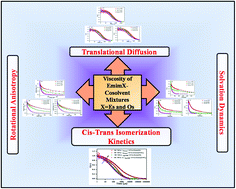The role of viscosity in various dynamical processes of different fluorophores in ionic liquid–cosolvent mixtures: a femtosecond fluorescence upconversion study†
Abstract
Literature reports provide ample evidence of the dynamical studies of various fluorophores in different room-temperature ionic liquid (RTIL)–cosolvent mixtures. However, most of the experimental and simulation studies reveal that ∼50% of the spectral relaxation dynamics is fast and cannot be resolved using traditional time correlated single photon counting (TCSPC) measurements. Our group has also investigated the dynamics of a solvatochromic probe coumarin 153 (C153) in a RTIL–cosolvent mixture using a TCSPC setup (S. Sarkar, R. Pramanik, C. Ghatak, P. Setua and N. Sarkar, J. Phys. Chem. B, 2010, 114, 2779–2789). Consequently, a major portion of the solvation dynamics remained undetected and moreover we could not monitor the dynamics beyond 0.4 mole fraction of the cosolvents. Thus in this study, we have rekindled our interest to sufficiently capture the rotational anisotropy and solvation dynamics of C153 beyond 0.4 mole fraction of the cosolvents in the RTIL–cosolvent mixture employing femtosecond fluorescence upconversion measurements. Additionally, we have utilized another RTIL with a higher alkyl chain length and viscosity to obtain a comprehensive and quantitative picture of the role of viscosity on the dynamics of the probe molecule. The most interesting observation of the present work is that the viscosities of different RTIL–cosolvent mixtures can efficiently control the cis–trans isomerization kinetics of the anionic fluorophore merocyanine 540 (MC 540) and the translational diffusion of a hydrophobic probe. The optimization of geometrical structures of [EmimOs]– and [EmimOs]–cosolvent mixtures followed by frequency analyses in both gas and solution phases have been carried out using quantum chemical calculations with the aid of density functional theory (DFT) methods. The computation based on the bond distances, electron densities and non-covalent interactions (NCI) has also been used to investigate the existence of the hydrogen-bond (H-bond). Again to comprehend van der Waals interactions and the conventional hydrogen-bond, the evolution of NCI plots are simulated. Therefore, the detailed experimental and theoretical studies presented in this manuscript lead to the inference that addition of the conventional solvents finely tunes the physicochemical properties of RTILs and broadens their scope of applications in the fields of chemistry and biology.



 Please wait while we load your content...
Please wait while we load your content...